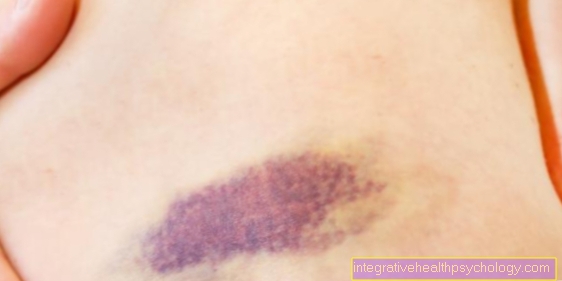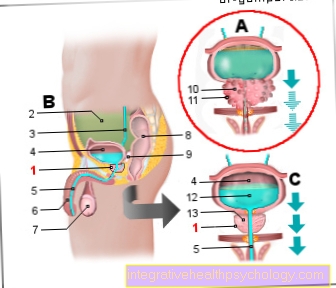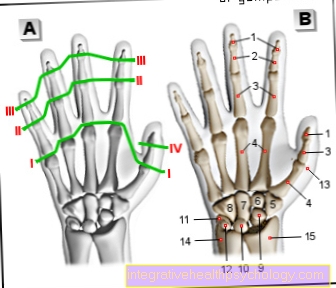pH test strips
What is a pH test strip?
Every fluid in the human body has a so-called pH value. This ranges between 0 and 12 and indicates whether a liquid is more acidic (0) or basic (14). The pH value of a liquid can be determined with a pH test strip (also called indicator strips, indicator strips or universal indicators). All you have to do is put some liquid on the strip, or hold the strip in the liquid. Depending on the pH value in the liquid, the indicator strip changes color to between red (acidic) or blue (basic). The pH value can then be read off relatively precisely using the color scale provided.
Read more on this topic at: pH in humans

Which pH values in the human body can be determined with it?
Most of the time, pH test strips are used to check the pH of the urine. The pH value of the vaginal secretion can also be determined with test strips for the vagina. This can also be used to detect amniotic fluid leakage or infections during pregnancy. Another less common area of application for pH test strips is the measurement of the pH value of saliva. The determination of the pH of other body fluids, such as blood, should always be done in a laboratory by a medical professional.
How do I use the pH test strip correctly?
The correct use of test strips depends on the body fluid being tested.
When testing urine, mid-stream urine should always be used. This means that the first part of the urine stream should be let into the toilet before the test strip is held in the urine stream or urine is collected in a container in which the test strip is then placed. Since the pH value of the urine depends on many factors, such as diet or time of day, the urine pH value should be determined at least three times a day, in the best case even six times a day. In addition, the pH value of the urine fluctuates within several days, so measurements should always be carried out on several days in a row before a general conclusion about the urine pH value is made.
The measurement of the pH value of saliva is controversial due to the strong influence of food. If you still want to determine the pH value of your saliva, you should definitely not eat or drink anything for at least two hours before the measurement. In the case of saliva, too, several measurements should be made throughout the day.
When measuring in the vagina, the indicator stick should be inserted a few centimeters into the vagina. There are also certain test gloves that have indicator paper on their index fingers. Taking the measurement with gloves is more hygienic than inserting the stick or paper with your finger. Here, too, several measurements should be made at several times and not just the value of a single measurement should be taken into account.
Read more on this topic at: vaginal pH
How is a pH test strip constructed?
In principle, the pH value is measured by so-called pH indicators, which change their color specifically at a certain pH range. In their simplest form, these indicators are applied to paper and the paper is rolled into a small roll and can be torn off in any length. Paper is particularly unsuitable for use with urine or in the vagina, which is why the indicators are often applied to sturdy paper or plastic sticks.
Which pH test strips are there?
Urine pH test strips
Simple indicator paper can be used for urine if the midstream urine has been collected in a special container. Urine that has already been in the toilet can no longer be used for pH measurement. Solid indicator sticks made of paper or plastic can be held directly in the urine stream.
pH test strips for amniotic fluid
If an increased pH value is measured in the vagina during pregnancy, this can be an indication of leaked amniotic fluid and thus - depending on the point in time - also indicate a rupture of the bladder too early. The normal pH of the vagina is relatively acidic and ranges from 3.8 to 4.4. The value of urine is also usually slightly acidic. Amniotic fluid, on the other hand, has a neutral to basic value of 6.5 to 7. If amniotic fluid escapes during pregnancy, for example through an unnoticed tear in the amniotic sac, the pH value in the vagina also rises. In this way, the pregnant woman herself can distinguish whether only small amounts of urine have escaped or amniotic fluid has escaped from the vagina. However, during testing, the values are often falsified by measurement errors or contamination. A doctor can do a test that will tell you whether or not the amniotic fluid has leaked.
pH test strips in pregnancy
In addition to checking for amniotic fluid leakage, pH test strips can also be used to check the pH of the vagina. If there is a so-called vaginal disorder, i.e. the pH value of the vagina is too high, bacteria can settle more easily in the vagina. These bacterial infections are the most common causes of premature labor and premature delivery. If an increased pH value is measured in the vagina for more than a day, a doctor should be consulted.
pH test strips for the vagina
Even outside of pregnancy, you can easily check the vaginal environment with a pH test strip or glove. Even in women who are not pregnant, an increased pH value in the vagina increases the risk of infection. The pH value in the vagina can also increase with vaginal thrush.
pH test strips for saliva
In principle, the pH value of saliva can be measured with any type of test strip. Here too, it is particularly important to observe the correct application (see above).
How long can you use pH test strips?
Every pH test strip changes color once it comes into contact with a liquid.The resulting color reactions are usually irreversible. This means that once the test strip has been used, it cannot be used again. In addition, strict attention should be paid to the package insert when storing. If the test strips are stored incorrectly, they can quickly become unusable.







.jpg)














-und-lincosamine.jpg)






